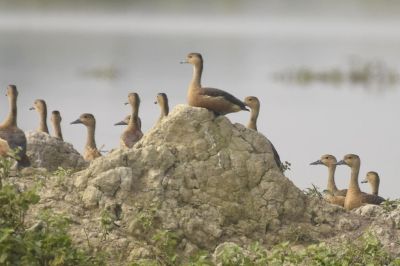Hollywood directors may want to consider yet another Red Dawn reboot, this time pitting Calumet High School’s Wolverines against a Chinese special forces unit with a particularly fowl reputation. “China once dispatched 100,000 duck troops to counter their adversary,” a recent viral Facebook video claims. “Every duck in the army served an important purpose that may save the entire country's population.”
The video, which has more than 215,000 views, was posted to Facebook by Unknown Facts—a page with more than 16 million followers run by the Mumbai-based website Genmice. It claims that China sent an army of 100,000 ducks to Pakistan, revealing later that this was done to help address a locust emergency. “A flock of 100,000 ducks has been dispatched to Pakistan, what caused this incident and who was to blame?” the video asks. Additionally, the video also asserts that the Chinese government has used geese to patrol its border with Vietnam. “There is a vicious gaggle of 500 geese standing to guard, fly, and ready to honk or bite anyone who dares to cross the border illegally.”
The claim that the Chinese government stationed geese at its border during the COVID-19 pandemic is true. While the video errs in its assertion that the Chinese government actually deployed a flock of web-footed soldiers to Pakistan, it accurately lays out why such a strategy was considered: pest control.
What’s the deal with ducks?
In 2020, the BBC reported that the Chinese government was considering using ducks to assist Pakistan in managing swarms of locusts that were devouring essential crops across the country. Heavy rainfall in 2019 along the Arabian peninsula led to a sizable uptick in the region’s locust population, resulting in widespread issues for farmers whose crops attracted the incredibly destructive insect swarms. Ducks, which can eat more than 200 locusts a day each, have been used for pest management since ancient times. In 2000, the Chinese government sent 30,000 ducks to Xinjiang to address a locust infestation in the province. It’s not just China who uses ducks for agriculture, either: Some vineyards use ducks to combat snails and other insects, and ducks in Thailand sometimes help maintain rice paddies.
After rumors of the operation received widespread attention across China, experts quickly responded that ducks were not a workable solution in Pakistan. “Ducks rely on water, but in Pakistan’s desert areas, the temperature is very high,” Zhang Long, a professor at China Agricultural University, told reporters at the time. The Pakistani government, with some international assistance, ended up using mostly oil-based ultra-low volume insecticide formulations instead, and it established a new multi-phased control policy and National Locust Control Center to respond to ongoing threats.
Though the U.S. does not have issues with native locust species—the incredibly destructive Rocky Mountain locust went extinct toward the end of the 19th century—it does face challenges related to grasshoppers and Mormon crickets. The use of ducks, however, is not currently part of the country’s response and prevention strategy. “Using vertebrates like birds or mammals as biocontrol agents is complicated,” Dr. Clayton Myers, a senior entomologist in the Department of Agriculture’s Office of Pest Management Policy, told The Dispatch Fact Check. “On a very small scale, like a backyard garden, you might see some benefit from a system like that. But trying to scale it up to control something like locusts, which break out across hundreds of square miles, we've never thought that would be an effective approach,” Myers explained. One of the primary issues with ducks is that they are considered “generalists,” meaning they eat a wide range of insects and foliage, making them less effective for a targeted pest management strategy. “The more generalist the predator, the less effective it's going to be as a biocontrol agent,” Myers said. “A duck or chicken is very generalist, so that sort of undermines their efficacy.”
The U.S. Department of Agriculture has a number of management programs for pest outbreaks, mostly administered through the Animal & Plant Health Inspection Service (APHIS). APHIS works both federally and through coordination with state and local officials to prevent pest outbreaks from reaching agricultural areas, primarily through the judicious use of pesticides.
But what about the goose guards?
Unlike the proposed 100,000 duck army, the Chinese government did in fact deploy a number of geese in 2021 to assist in maintaining its zero-COVID policy. In April 2022, National Geographic reported that a gaggle of approximately 500 geese had been deployed across 300 miles of China’s border with Vietnam in order to help prevent illegal crossings. The Paper, a Chinese state-run news organization, reported that two individuals were captured crossing the border in December 2021 following alerts from the geese.
According to a 2006 textbook on industrial security management, geese are extremely effective and inexpensive security personnel—particularly in large and isolated locations—and the most popular geese breeds for guard duties are the Black African and White Chinese varieties. “Domestic geese are excellent guards, being highly aggressive, especially during the breeding season when the ganders are fiercely and fearlessly defensive of sitting females on their nests and subsequently their goslings,” Dr. Anthony David Fox, professor of waterbird ecology at Aarhus University, told The Dispatch Fact Check “They are incredibly loyal to their human protectors as well as their families and have excellent night vision, so can be vigilant and just as aggressive by night as by day.”
The effectiveness of geese for security purposes also derives from their profound alertness, and the birds sleep with one side of the brain awake at all time—keeping one eye open to watch for predators. “Once an intruder is spotted, they will not only raise a commotion, but may even attack the invader with or without the rest of the flock,” Fox explained. Notably, genetic analysis suggests that modern domesticated geese diverged from their wild counterparts almost 16,000 years ago, implying that humans may have domesticated them before even dogs. “[Humans] may have exploited [geese’s] ability to aggressively alert humans to intruders that long ago,” Fox remarked.
China is not the only country to employ geese in security and defense, and rumors even exist—forwarded by the famed Roman historian Livy in The History of Rome published between 27-25 B.C.—that geese alerted Roman soldiers of an attack by the Gauls on Capitoline Hill during the 390 B.C. sack of Rome, allowing the soldiers there to repulse the invaders. Likewise, in 1986, supposedly inspired by the Ballantine scotch distillery’s famous brigade of guard geese in Dumbarton, Scotland, about 900 geese were reportedly placed by the U.S. military at a number of strategic locations across Europe. The U.S. Army’s 32nd Air Defense Command deployed 30 platoons of six to 40 geese each in order to guard communications, radar, and anti-weapons equipment in the region. When reached for comment, a press officer for the 32nd Air Defense Command told The Dispatch Fact Check that he was unaware of the command’s past association with guard geese.
Despite their historical service, there are no reports suggesting the use of geese in modern U.S. military operations, particularly during a period of increased reliance on special operations units. “I cannot speak publicly about tactics, techniques, procedures, or whether or not we did, or in fact did not use winged conscripts in the execution of Special Operations missions," Andy Stumpf, a former DEVGRU—more commonly known as SEAL Team Six—operator told The Dispatch Fact Check. However, Stumpf did confirm that anti-combat swimmer dolphins are in fact trained and utilized by the U.S. Navy. The Marine Mammal Program—based in San Diego, California—is responsible for training bottlenose dolphins and California sea lions in tasks such as locating and marking objects. Though they do not publicly recognize the use of dolphins for combat, a number of former Navy divers have reported partaking in training exercises involving dolphins that have been trained to hunt down and kill enemy divers. These dolphins supposedly head-butt swimmers with special devices attached to their heads that contain a compressed gas needle, often resulting in a fatal embolism for the diver. The Maritime Mammal Program did not return a request for comment.
If you have a claim you would like to see us fact check, please send us an email at factcheck@thedispatch.com. If you would like to suggest a correction to this piece or any other Dispatch article, please email corrections@thedispatch.com.






Please note that we at The Dispatch hold ourselves, our work, and our commenters to a higher standard than other places on the internet. We welcome comments that foster genuine debate or discussion—including comments critical of us or our work—but responses that include ad hominem attacks on fellow Dispatch members or are intended to stoke fear and anger may be moderated.
With your membership, you only have the ability to comment on The Morning Dispatch articles. Consider upgrading to join the conversation everywhere.